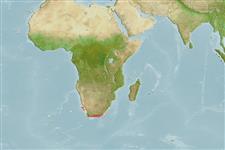Пластиножаберные (акулы и скаты) (sharks and rays) >
Carcharhiniformes (Ground sharks) >
Pentanchidae (Deepwater catsharks)
Etymology: Haploblepharus: haplos (Gr.), single or simple; blepharon (Gr.), eyelid, referring to simple structure of lower eyelid, which closes against upper eyelid to protect the eye (See ETYFish); edwardsii: In honor of English naturalist George Edwards (1694-1773), known as the “father of British ornithology,” who was the first to illustrate this shark, in 1760 (See ETYFish).
Eponymy: George Edwards (1694–1773) was an illustrator, naturalist, and ornithologist. [...] (Ref. 128868), visit book page.
Environment: milieu / climate zone / пределы глубины / distribution range
экология
морской демерсальный; пределы глубины 0 - 130 m (Ref. 5510), usually 40 - 130 m (Ref. 5510). Subtropical; 29°S - 35°S
Southeast Atlantic: Cape Agulhas to Natal in South Africa. There are two different forms of this species, the 'Cape' and 'Natal' types, which differ in coloration and habitat and might be geographic variants or two distinct species (Ref. 6782).
Length at first maturity / Size / Вес / Возраст
половая зрелость: Lm ?, range 41 - ? cm
Max length : 59.0 cm TL самец/пол неопределен; (Ref. 244); 60.0 cm TL (female)
Краткое описание
определительные ключи | морфология | морфометрия
колючие лучи спинного плавника (общее число) : 0; колючие лучи анального плавника: 0. Southeastern Cape form: sandy brown with 7 reddish-brown saddles bordered by black, and numerous small, dark brown and white spots between saddles; white below (Ref. 5578). Natal form: body cream in color with darker brown saddles and irregular white spots; white below (Ref. 5578).
Body shape (shape guide): elongated.
Found in inshore and offshore waters of the continental shelf, on sandy and rocky bottoms (Ref. 244). Feeds on bony fishes, crustaceans and cephalopods (Ref. 244). Oviparous (Ref. 50449). Caught by surf anglers (Ref. 244).
Oviparous, with 1 egg-case laid per oviduct (Ref. 244). Embryos feed solely on yolk (Ref. 50449).
Compagno, L.J.V., 1984. FAO Species Catalogue. Vol. 4. Sharks of the world. An annotated and illustrated catalogue of shark species known to date. Part 2 - Carcharhiniformes. FAO Fish. Synop. 125(4/2):251-655. Rome: FAO. (Ref. 244)
Статус Красного Списка МСОП (Ref. 130435: Version 2025-1)
Угроза для людей
Harmless
Использование человеком
рыболовство: рыболовство как средство для существования; объект спортивного рыболовства: да
дополнительная информация
инструменты
Специальные отчеты
Скачать в формате XML
ресурсы в Интернет
Estimates based on models
Preferred temperature (ссылка
123201): 12.8 - 20.5, mean 16.3 °C (based on 24 cells).
Phylogenetic diversity index (ссылка
82804): PD
50 = 0.5625 [Uniqueness, from 0.5 = low to 2.0 = high].
Bayesian length-weight: a=0.00355 (0.00175 - 0.00721), b=3.08 (2.90 - 3.26), in cm total length, based on LWR estimates for this (Sub)family-body shape (Ref.
93245).
Trophic level (ссылка
69278): 3.8 ±0.3 se; based on diet studies.
устойчивость к внешним воздействиям (ссылка
120179): очень низкий, минимальное время удвоения популяции более 14 лет (Fec assumed to be <10).
Fishing Vulnerability (Ref.
59153): Moderate vulnerability (44 of 100).
🛈
Nutrients (Ref.
124155): Calcium = 29.5 [4.8, 158.9] mg/100g; Iron = 0.746 [0.202, 2.212] mg/100g; Protein = 18.4 [15.3, 21.4] %; Omega3 = 0.195 [0.086, 0.425] g/100g; Selenium = 20.3 [6.1, 57.3] μg/100g; VitaminA = 11.3 [4.0, 31.8] μg/100g; Zinc = 0.647 [0.307, 1.195] mg/100g (wet weight);
